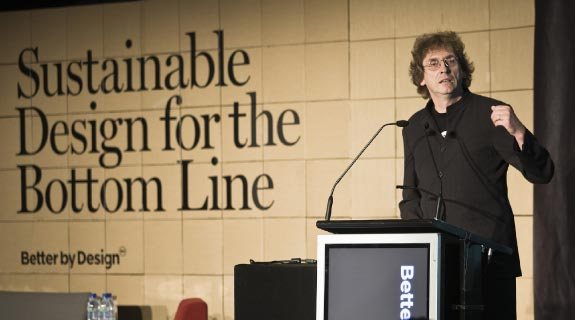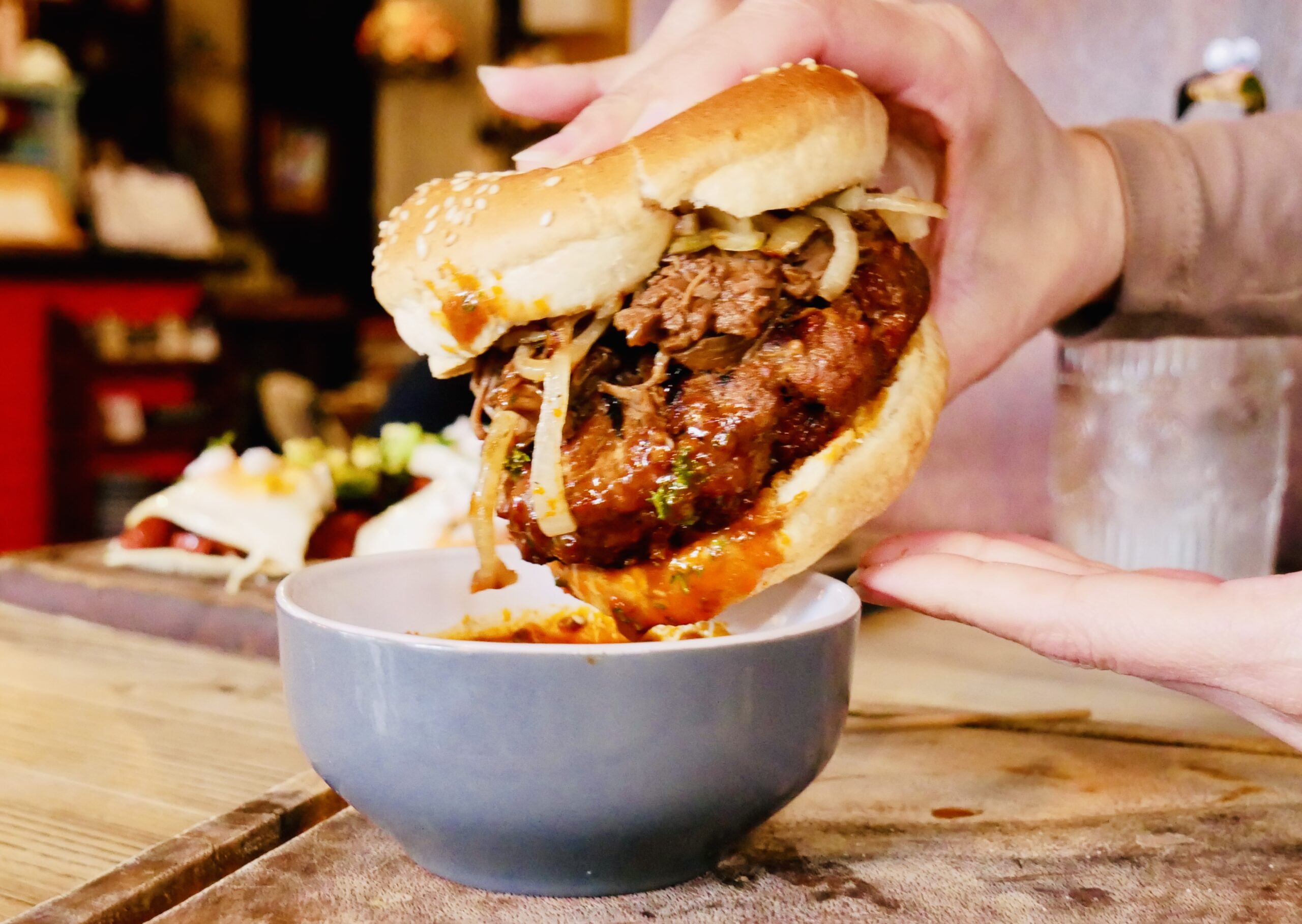Vincent Heeringa interviews Michael Braungart, co-author of Cradle to Cradle, about the world’s bright green future, and how New Zealand can brighten up.
Vincent Heeringa’s ‘Bright green future’ interview with Michael Braungart, in full.
Michael Braungart speaking at ‘Sustainable Design for the Bottom Line’, a business conference held in September by NZTE’S Better By Design
Can you explain the concept of cradle-to-cradle, in simple terms?
Traditionally people think from cradle to grave: so they take things, they make things, and they bury things. Which means that the whole planet turns into a big graveyard. So cradle to cradle says ‘let’s plan to make things, design them from the beginning, and plan the next life of the biosphere’. It’s no longer about reducing waste, it’s not about reducing the footprint, it’s not about minimising or avoiding. It’s about being good.
There are two areas to focus on. Things which are consumed, like food, like detergents, like shoe soles, like any type of thing which gets upgraded, or physically and chemically changed when you use them. These things need to be redesigned, recycled and returned so that they are good for the biosphere. And everything that is used as a service, like a washing machine, like a window, like radio or a TV set—that you don’t consume—it needs to be designed to go to the technosphere.

{% fishpond 1248759 %}
The idea behind cradle to cradle is to return everything we make to either the biosphere—as soil or atmosphere or water—or the technopshere—for use in devices.
It does not mean the end of toxins. You cannot make a TV set without toxic stuff in it. The European Union does a lot of this ‘ecologism’. For example they have been banning lead in electronic products. But they never ask ‘what is the replacement?’. The replacement is tin, silver, copper, nickel and bismuth. When you use bismuth to replace lead, you must source it from lead. In nature, bismuth only comes with lead. With one tonne of bismuth you’re generating 10 tonnes of lead. So by making things ‘lead free’, you make more lead.
So that’s why in cradle-to-cradle you define what you have. Every ingredient would be good for the biosphere, or the technosphere. It’s no longer about minimising your impact.
Here’s an extreme example to illustrate my point: The government here [in NZ], for example, says please protect the environment; don’t use your cars that often. It would be the same effect if we would say, ‘please protect your child, don’t beat your child that often’. So protection means active support, and cradle to cradle is a simple strategy. To make things which are good for the biosphere, are good for the technosphere. And then see it’s not waste anymore, it’s only nutrient management.
The idea of making our business or driving or living or building beneficial for the environment seems like a wonderful fantasy.
Yeah, but it’s not. Take biodiversity in the city of Berlin: it’s four times higher than the surrounding agricultural area, thanks to parks and roof top gardens. We work with a company who does nine out of the ten worldwide biggest green rooves. On most of these rooves we get species of birds back which haven’t been seen for decades there.
But also we cannot talk about fantasy because it needs to happen now. It’s not about minimising the carbon dioxide emissions. We will not be successful with just doing that. It’s about rebuilding the ay we do things. When we lose 5,000 tones of topsoil then we need to rebuild topsoil first. So we work in the Netherlands, for example, on projects which we call horizontal chimneys. The carbon dioxide is just too rare to put in the atmosphere so we use the carbon dioxide directly to grow micro organisms, to grow water plants and we feed them to shrimps, yeah? You can look on the internet, it’s under Happy Shrimp. Using the carbon dioxide as a nutrient and we create growth rates up to 20 percent a day.
In New Zealand we have a company called Lanzatech which is using emissions from steel mills to generate ethanol.
Yeah, sure. That’s the same thinking. Carbon is far too rare to put into the atmosphere. It’s only 2.1 percent of the earth’s crust. How can we be so stupid as to put it in the atmosphere?
So you are promoting a new philosophy that ditches the old green approach of naming and shaming. But you still have a few choice words for some, such as Mattel.
Oh sure. Sure. They’re just too stupid ignore. They’ve been making toxic toys for children for decades. It’s a type of child abuse. They are like a terrorist using chemical weapons. I used the opportunity in 2003 when I got the Green Chemistry award by President Bush, to say ‘look, you don’t need to go to Iraq because the chemical weapons are here. You’ll find chemical weapons just in your children’s room’. In the United States the nice thing is you can say these things, and as long as it’s funny they respect it. Even if they have completely different opinions, and that’s nice. In Europe science has to be boring otherwise people don’t buy into it.
Your ‘ABC-X’ ranking of inputs into the industrial process is cool but the implications for accounting for them all, let alone chaning them, is enormous. It’s a big industrial shop we need to turn around.
Yes it is; 80 percent of the materials that have been invented and designed are affected by this regime. About two thirds of all the materials which are used right now are basically not designed for human beings. And when you take an average building here, you see that the inter-air quality in the building is between three to eight times worse than outside urban air. In Germany people only get tax breaks and tax cuts when they can prove that their house is sealed.
Even the Nazis didn’t pay subsidies for gas chambers, yeah? And now you need to seal your house full of toxins.
But the point is that the X component out of your ABCs is so enormous, are you confident that we can find a replacement for Xs?
For sure. The thing is we do a project, for example, with Acta and DSM, two Dutch chemical international clients, and what happens is now that the young generation of scientists is coming who just want to be proud of what they do. I think it’s no longer about green, it’s about good. So it’s about holistic quality.
So Rachel Carson [author of Silent Spring] was correct?
Yeah, that’s one of the saddest things that in 1962 basically everything was clear. And the problem is that in Europe and here and in Australia and in a lot of countries you could only pay for problems, not for solving problems. In 1982, 20 years after Rachel Carson, I took some of the chemicals like plasticisers for PVC, because at that time it was clear that they destroy male fertility, they behave like hormones. So I made a draft for legislation to stop the production of these substances. What happened is it took five years to do an analytical test method everybody could agree on the testing.
Then it took five years of monitoring, then it took five years of a toxicological evaluation of it, then it needed five years of a debate about it and then it needed three and a half years of decision making. And what happened? At the same time basically the male population in Europe lost about one-third of its fertility. And now we have about 20 percent of the men, for example, in a city like Hamburg, which want to have children and can’t because they are just basically sterile.
Are you confident that we can replace the petro-chemical components of our economy?
No, it’s not necessary. First of all, there are plenty of petro-chemical components for making medicines and making high quality polymers. For example, at Herman Miller (we did the chemicals for the Mirra chair) they can tell you that polypropylene which you have there only takes 1.1 tonnes of oil to make one tonne of polypropylene. So basically it’s a very elegant way to store oil in the long term.
And polypropylene is designed with all the additives and pigments that you can use it in, at least for 200 times. So why should you change that? What’s stupid is that more than 80 percent of the petro-chemicals are just burned as a fuel and that’s the most primitive use of it.
Cradle-to-cradle suggests re-use forever, right?
You melt it and use it, melt it, use it. So this chair, the mirra chair is the most profitable chair Herman Miller ever made. It has a profit, that’s why I said don’t put it in the green because it’s about innovation, yeah?
I want you to just imagine that you’re in New Zealand for a little bit longer. We have several dynamics to our economy. We’re predominantly agriculture still, but very high-tech agriculture: highly productive, high yields, very efficient. We also have an problem, but also a benefit, around distance. So everything we sell internationally must go long distance. But the benefit is that we have low population and abundant natural resources.
I don’t know if you’ve given any thought to applying cradle-to-cradle thinking to our economy but what might that mean for us? How would we benefit, how do we need to change to capture the opportunity?
Well, first of all your society is pretty much optimistic, yeah? And they don’t take themselves that seriously.
Certainly not.
Yeah. So it’s not only people, planet, profit, it’s pleasure as well. If it’s not fun, don’t do it, yeah? A little self knowledge, or irony, is very nice because it’s very creative. People don’t have fear which is nice because out of fear you’re not creative. We know that there are similar countries which go into cradle to cradle and one of that is Israel.
But when you question the existence of somebody every day then it’s not very productive. But you would recommend to partnerships to other countries, like Taiwan is very fierce on cradle to cradle. Or the Netherlands even. The Netherlands decided to change the whole country in the next four years, so in 2012 all the public purchasing which is more than $60 billion will be cradle to cradle. And so there are hundreds of architects who do cradle to cradle architecture, so there’s no curriculum at any university which doesn’t cover cradle to cradle because it’s a positive agenda. The Dutch basically could never romanticise nature, so they could never talk about Mother Nature because the next flood takes them away.
Well we’ve got a utilitarian culture because we’re farmers.
Yeah, very pragmatic which is nice. It’s similar like the Dutch. And Israel. It’s because of the isolated situation. You always need to think about how to support your neighbour because in the case of an emergency you always need your neighbour. And it’s a similar thing in the Netherlands. So I would say there are a lot of structural similarities.
And what’s the implication for cradle to cradle in that?
It’s a traditional egalitarian thinking. Cradle to cradle is a culture of support. So ‘what can I do for you that’s good for you and for this planet’? So I want to look at a child and say ‘hey, what a potential, what an opportunity for nature, what a possibility to support others’.
What are the implications for agriculture?
For agriculture it means complete change. First to say ‘let’s rebuild soil’. Soil erosion is a huge huge problem here. And two-thirds of all the carbon is in soil, so how can you talk about minimising emissions instead of really capturing the carbon in the soil? So –
Can we be the reverse? Can we be carbon farmers for instance?
Yeah, yeah, that’s exactly what it should be. Nobody understands this in Europe. In Europe we are losing, in one year, carbon topsoil which has been built in five thousand years in one year. So if you don’t rebuild soil, forget about it. So it’s, it’s not a greenhouse problem, it’s a carbon dioxide management problem. That’s why it makes sense to understand the carbon dioxide as an asset, as an opportunity and then we can be, it can be far more productive.







